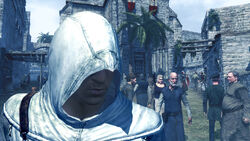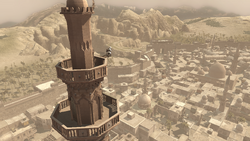 Doom (stylized as DOOM and originally known as Doom 4) is the upcoming reboot of the Doom series by id Software following the release of its last title, Doom 3, in 2004. It will be released on Microsoft Windows, PlayStation 4, and Xbox One in 2016. After years in development with almost no news from id Software, it was restarted completely in 2011 with Bethesda Softworks serving as the publisher for the game.
Doom (stylized as DOOM and originally known as Doom 4) is the upcoming reboot of the Doom series by id Software following the release of its last title, Doom 3, in 2004. It will be released on Microsoft Windows, PlayStation 4, and Xbox One in 2016. After years in development with almost no news from id Software, it was restarted completely in 2011 with Bethesda Softworks serving as the publisher for the game.
The game takes place on Mars, where the UAC Corporation have been discovering artificial symbols that marked Mars and brings demons from hell.
The game was announced as in production on May 7, 2008,[6] after John Carmack, then lead developer at id Software, hinted it at QuakeCon on August 3, 2007.[7] Id Software's CEO Todd Hollenshead suggested that, like Doom II: Hell on Earth, it will take place on Earth,[8] and will feature gameplay more akin to the original Doom games rather than the horror styled gameplay of Doom 3.[9]
On August 1, 2008, John Carmack said that Doom 4 will look three times better than Rage does, intended to run at 30 frames per second; on Xbox 360 and PlayStation 3; rather than 60 that Rage targets.[10] In its Windows version, Doom 4 was intended to run at 60 frames per second with state-of-the-art hardware.[11] In 2009, he revealed that the multiplayer component is being developed separately and will run at 60 frames per second.[12] Carmack stated in 2011 that "you can't have 30 guys crawling all over you at 60 frames per second at this graphics technology level because it's painful. -- So, [in single-player] we can have 30 demons crawling all over you on there."[13]
In April 2009, Hollenshead said Doom 4 was "deep in development". When asked if Doom 4 would be "a sequel? A reboot? A prequel?", his response was: "It's not a sequel toDoom 3, but it's not a reboot either. Doom 3 was sort of a reboot. It's a little bit different than those."[14]
On June 23, 2009, ZeniMax Media, best known for Bethesda Softworks, acquired id Software and announced that all future id games will be published by Bethesda Softworks, including Doom 4 in addition to Rage and future Quake titles.[15] Carmack said at Quakecon 2011 that once Rage shipped its development team would move to Doom 4 to speed up on that project. Doom 4 might also feature dedicated servers unlike Rage.[16]
At the 2011 QuakeCon, Carmack mentioned that new Doom will be using a new scripting language that is based on C++, and called it "super-script". This so-called "super-script" is a subset of C++; with features like scheduling and type safety.[16] In February 2012, some alleged screenshots were released on Official Xbox Magazine UK's website,[17] but the images were discredited by id Software's creative director Matthew Hooper.[18] In November 2013, Carmack left id Software to commit to his work at Oculus VR.[19]
In April 2013, Kotaku published an exposé describing Doom 4 as trapped in "development hell". Citing connections to id, the article claims that Doom 4 has suffered under mismanagement, and that development was completely restarted in 2011. Inside sources described the pre-2011 version, which was to portray the uprising of hell on Earth, as heavily scripted and cinematic, comparing it to the Call of Duty franchise. The pre-2011 version was criticized as mediocre, but the sources also described the new version as "lame" and a "mess".[20] Id's Tim Willits said during Quakecon 2013: "Every game has a soul. Every game has a spirit. When you played Rage, you got the spirit. And [Doom 4] did not have the spirit, it did not have the soul, it didn’t have a personality
 On June 10, 2014, a teaser trailer of Doom[24] was presented at Electronic Entertainment Expo 2014 as well as at QuakeCon's website and at a new official Doom website. A more expansive trailer was unveiled at QuakeCon 2014 on July 17, 2014, where a closed presentation was made mainly to silence ongoing rumors of the project being in jeopardy.[25] From what was seen in the QuakeCon presentation, the new Doom is to feature mechanics such as melee combat, finishing moves, and the ability to rip someone's arm off and use it to open a biometric security door.[25] Also said to be featured in the game are double jumping and freedom of movement such as vaulting and manteling.[26] On July 19, 2014, in light of Crytek's financial difficulties, it was announced that Tiago Sousa, head R&D graphics engineer at Crytek, was leaving to join the Doom and idTech 6 engine team.[27] On May 18, 2015, a brief teaser trailer was released to promote gameplay being shown at E3 2015 on June 14, 2015; the trailer depicted the double-barreled shotgun, and the Revenant, a monster returning to the game.[28] On June 14, 2015, around 15 minutes of gameplay footage were shown at E3 and the release date was revealed to be Q1/Q2 2016.
On June 10, 2014, a teaser trailer of Doom[24] was presented at Electronic Entertainment Expo 2014 as well as at QuakeCon's website and at a new official Doom website. A more expansive trailer was unveiled at QuakeCon 2014 on July 17, 2014, where a closed presentation was made mainly to silence ongoing rumors of the project being in jeopardy.[25] From what was seen in the QuakeCon presentation, the new Doom is to feature mechanics such as melee combat, finishing moves, and the ability to rip someone's arm off and use it to open a biometric security door.[25] Also said to be featured in the game are double jumping and freedom of movement such as vaulting and manteling.[26] On July 19, 2014, in light of Crytek's financial difficulties, it was announced that Tiago Sousa, head R&D graphics engineer at Crytek, was leaving to join the Doom and idTech 6 engine team.[27] On May 18, 2015, a brief teaser trailer was released to promote gameplay being shown at E3 2015 on June 14, 2015; the trailer depicted the double-barreled shotgun, and the Revenant, a monster returning to the game.[28] On June 14, 2015, around 15 minutes of gameplay footage were shown at E3 and the release date was revealed to be Q1/Q2 2016.




